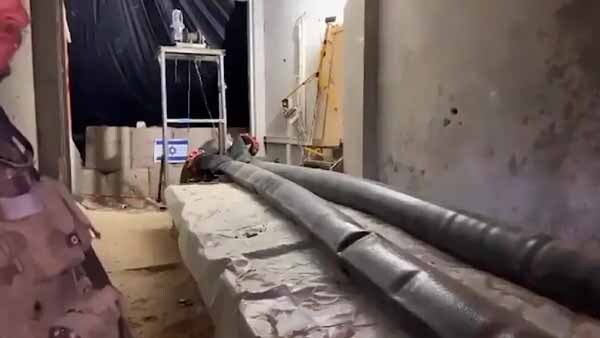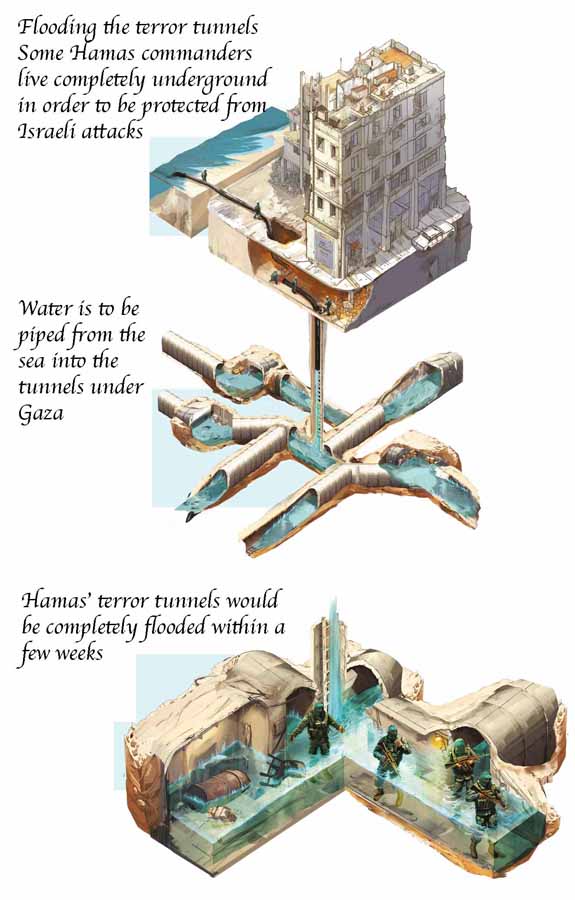
The Israeli army has completed the assembly of at least five seawater pumps to pump water into Hamas terror tunnels.
DLNews World at War:
"Why flooding the terror tunnels is a risky business."
Hamas has dug more than 800 terror tunnels in Gaza since 2007, and hidden in them are ammunition, explosives, and rockets, which it uses for attacks on Israel.

The tunnel system, also known as the "Gaza Metro" due to its size of about 310 Miles and its use as a transport system for Hamas, is used as a terrorist safe house. Hostages who were kidnapped on October 7 during the Hamas massacre in Israel will also continue to be held in some of the tunnels.
Now, the Israeli army (IDF) is planning to flood parts of the tunnel system to bring the terrorists to the surface! Preparations are in full swing.
As the "Wall Street Journal" reports, the IDF has assembled a system of large pumps to flood Hamas' extensive network of tunnels under the Gaza Strip with seawater.
Code name: "Atlantis"
According to the report, Israeli forces installed at least five large seawater pumps about 1.6 kilometers north of the Al-Shati camp in Gaza in mid-November.
An Israeli military expert explains: "These are huge and powerful pumps developed in the Israeli defense system and the defense industry. They pump thousands of cubic meters of water and direct it into the tunnels closest to the sea." The terror tunnels would be flooded within a few weeks.
It is a pilot project because Israel has never carried out such flooding before. Israel has not yet made a final decision on whether or when the Hamas tunnels could be flooded.
The most significant risk: Hamas is probably still holding hostages in the tunnels!
"Of course, we won't flood any tunnels where we know there are Israeli hostages," emphasizes the Israeli military expert.
Israel assumes that the abductees were moved from the north of the Gaza Strip to the south a long time ago. Possible flooding is initially only planned in the north.
As it is unclear how permeable the tunnels are or how much seawater would penetrate the ground, it isn't easy to fully assess the effects of discharging seawater into the tunnels. In concrete terms, this means that if the tunnels and everything around these structures were to become waterlogged, large parts of the buildings above ground could also collapse. Civilian casualties would be feared.
And finally, the drinking water supply is also considered to be at risk, partly because of the suspected huge weapons depots.
However, this would not be the first tunnel in Gaza attacked. Egypt has already flooded tunnels in Gaza once before. Back in 2015, Egypt used seawater to flood the tunnels operated by smugglers under the Rafah border crossing to the Gaza Strip. This led to complaints about damaged crops from farmers nearby.
However, military forces tasked with clearing tunnels, including Israel, usually use dogs and robots to search for threats or hostages.

At Desert Local News, connections are everything. We're not just another social networking platform—we're a lively hub where people from all walks of life come together to share stories, spark ideas, and grow together. Here, creativity flourishes, communities grow stronger, and conversations spark global awareness.
Comments